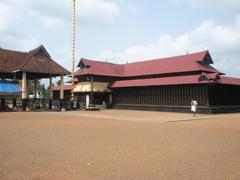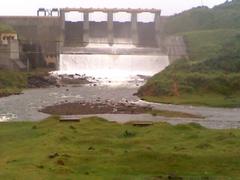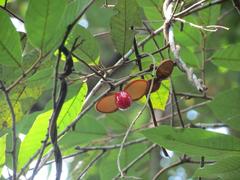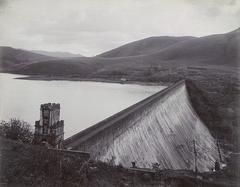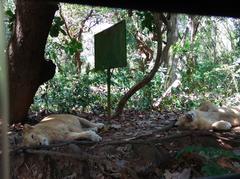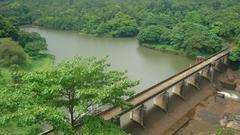Peechi Dam Visiting Hours, Tickets, and Comprehensive Travel Guide to Kerala’s Historical Landmark
Date: 14/06/2025
Introduction
Nestled amid the verdant landscapes of Thrissur district, Kerala, Peechi Dam is a remarkable confluence of engineering achievement, ecological conservation, and cultural legacy. Built in the 1950s under the vision of Ikkanda Warrier and inaugurated in 1957, this concrete gravity dam across the Manali River transformed Thrissur’s agricultural landscape, emerging as a lifeline for irrigation and a vital drinking water source for the region. Today, Peechi Dam stands as both an essential infrastructure asset and a captivating tourist destination, drawing visitors with its scenic beauty, rich biodiversity, and proximity to cultural landmarks.
This detailed guide provides everything you need to plan a memorable visit to Peechi Dam, including up-to-date visiting hours, ticket and accessibility information, travel tips, and insights into nearby attractions. It also highlights sustainable tourism initiatives and ongoing management efforts that ensure a safe and enriching environment for all.
For official updates and further details, consult resources from the Kerala Irrigation Department, TravelSetu, and DTPC Thrissur.
Table of Contents
- Introduction
- Historical Background and Engineering Significance
- Environmental and Ecological Impact
- Socio-Cultural Importance
- Evolution as a Tourist Destination
- Practical Visitor Information
- Sustainable Tourism and Safety Initiatives
- Frequently Asked Questions (FAQ)
- Summary and How to Stay Updated
- References
Historical Background and Engineering Significance
Origins and Construction
Peechi Dam was envisioned shortly after Indian independence, with construction commencing in the early 1950s under Ikkanda Warrier, the first Prime Minister of Kochi state. The dam was officially inaugurated in 1957 by Kerala’s first Governor, Burgula Ramakrishna Rao, and completed in 1959. Built as a straight concrete gravity structure, it was designed to withstand the region’s heavy monsoon rains while providing reliable irrigation and drinking water to Thrissur and its surroundings (Kerala Irrigation Department; KIIDC DPR).
Purpose and Features
Peechi Dam irrigates approximately 17,555 hectares of farmland, supporting agricultural prosperity and food security. It also serves as Thrissur’s primary source of potable water and mitigates monsoon flooding through its spillways and sluice gates. Modernization projects, such as those under the Dam Rehabilitation and Improvement Project (DRIP), ensure its ongoing safety and operational efficiency (IDRB Kerala).
Environmental and Ecological Impact
The creation of the Peechi Dam reservoir led to the establishment of the Peechi-Vazhani Wildlife Sanctuary in 1958. This sanctuary, spanning 125 km², is home to elephants, leopards, rare birds, and diverse flora—making it a biodiversity hotspot and an essential ecological corridor (KIIDC DPR). Botanical gardens and nature trails near the dam promote conservation awareness and eco-tourism, while ongoing research supports adaptive water management in response to climate change (IRJET Study).
Efforts to mitigate environmental challenges include protected zones, biodiversity monitoring, and maintaining ecological connectivity (Kalpavriksh Report).
Socio-Cultural Importance
Peechi Dam has been instrumental in transforming Thrissur’s rural economy by providing stable irrigation, boosting crop yields, and enabling diversification into cash crops and horticulture (Kerala Irrigation Department). It also supports urban growth by supplying drinking water to Thrissur city.
Culturally, the dam is a beloved local landmark, frequented for family outings, film shoots, and festivals. The surrounding gardens and picnic areas make it a favorite weekend retreat, while initiatives like the “Irrigation Tourism Project” promote sustainable tourism and local employment (KIIDC DPR).
Evolution as a Tourist Destination
Peechi Dam has evolved into a major tourist hub in Kerala, thanks to its scenic water cascades, lush gardens, wildlife sanctuary, and recreational facilities. Integrated eco-tourism initiatives, such as its inclusion in Kerala’s “Green Tourism Destinations” under the ‘Malinya Muktham Nava Keralam’ campaign, highlight a commitment to responsible visitation and environmental stewardship. The dam’s accessibility and family-friendly amenities further enhance its appeal (TravelSetu).
Practical Visitor Information
Visiting Hours and Tickets
- Timings: Generally open daily from 8:00 AM to 6:30 PM. (Some sources mention 9:00 AM to 5:00 PM; confirm locally for any changes.)
- Entry Fees: ₹10 for adults, ₹5 for children (as of 2024; may vary). Additional parking and boating fees may apply.
- Ticketing: Purchase tickets at the entrance; group and guided tour bookings are available through Kerala Tourism.
How to Reach Peechi Dam
- By Road: 22–23 km from Thrissur city; accessible via frequent buses, taxis, and private vehicles. Travel time is around 45 minutes.
- By Rail: Nearest major station is Thrissur.
- By Air: Cochin International Airport, approximately 68–70 km away.
Accessibility and Facilities
- Differently-Abled Access: Wheelchair-friendly paths in most public areas; visitor center assistance available.
- Facilities: Ample parking, restrooms, refreshment stalls, children’s play areas, picnic spots, and botanical gardens. Boating is offered seasonally, and nature trails are open for guided walks.
Nearby Attractions
- Peechi-Vazhani Wildlife Sanctuary: Just 1 km from the dam, ideal for wildlife watching and nature walks.
- Vadakkunnathan Temple: Historic temple in Thrissur city.
- Botanical Gardens: Showcasing native flora and fountains.
- Thrissur Pooram Festival: Kerala’s most famous cultural festival, held annually in Thrissur.
Sustainable Tourism and Safety Initiatives
Recognized as a “Green Tourism Destination,” Peechi Dam features:
- Waste Management: Color-coded bins, composting, and regular clean-up drives.
- Conservation Efforts: Visitor limits during peak seasons, eco-friendly infrastructure, and educational programs.
- Community Engagement: Local employment opportunities, regular consultation with residents, and support for sustainable development.
- Safety: Ongoing upgrades under DRIP, regular maintenance, and up-to-date Emergency Action Plans for monsoon seasons (Kerala State Disaster Management Authority).
Activities and Attractions for Visitors
- Boating: Seasonal, depending on water levels.
- Nature Walks and Birdwatching: Especially rewarding in the mornings.
- Picnicking: Well-maintained gardens and shaded spots.
- Children’s Park: Safe play areas and scenic gardens.
- Photography: Mobile phones allowed; cameras restricted for security.
- Educational Tours: Guided visits for schools and colleges focusing on engineering and ecology.
Frequently Asked Questions (FAQ)
Q1: What are the Peechi Dam visiting hours?
A1: Typically from 8:00 AM to 6:30 PM daily, but confirm locally for variations.
Q2: How much is the entry fee?
A2: ₹10 for adults, ₹5 for children; additional charges may apply for parking and boating.
Q3: Is Peechi Dam accessible for visitors with special needs?
A3: Most public areas are accessible; assistance available at the visitor center.
Q4: Are guided tours available?
A4: Yes, bookable through Kerala Tourism or local authorities.
Q5: What is the best time to visit?
A5: October to March offers pleasant weather; monsoon (June–October) is ideal for viewing water cascades.
Summary and How to Stay Updated
Peechi Dam exemplifies the harmonious integration of engineering excellence, environmental stewardship, and cultural richness in Kerala’s Thrissur district. Since its completion, it has supported agriculture, supplied drinking water, and evolved into a premier eco-tourism destination with attractions like scenic cascades, lush gardens, and a wildlife sanctuary. Ongoing sustainability initiatives and community involvement ensure its preservation for future generations.
To stay informed about visiting hours, ticketing, events, and seasonal changes, always consult official sources or the DTPC Thrissur website. For personalized travel tips, download the Audiala app and follow us on social media.
References
- Kerala Irrigation Department
- TravelSetu
- DTPCThrissur
- KIIDC DPR
- Holidify
- Kerala State Disaster Management Authority
For more on Kerala’s historical sites, explore our guides on Athirappilly Waterfalls and Guruvayur Temple. To enhance your visit, also see articles on “Top Historical Sites to Visit in Thrissur” and “Best Nature Trails Near Thrissur.”
Image suggestions: Use high-quality photos with descriptive alt text such as “Peechi Dam boating experience”, “Scenic view at Peechi Dam Thrissur”, and “Peechi Dam botanical garden native plants”.
